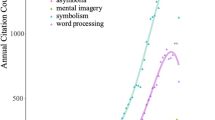Abstract
Previous research suggests that verbal deficits among psychotic children may be paralleled by deficits in nonverbal pantomime. However, certain questions such as the level of pantomime exhibited by psychotic children, its susceptibility to modification, and its relation to other symbolic functions have not been systematically examined. To investigate these issues, 24 psychotic children were required to represent absent objects (e.g., toothbrush) via pantomime after receiving verbal instructions or instructions accompanied by a model demonstrating the pantomime. Also, measures of receptive and expressive speech, human figure drawings, and pretend play were obtained. The findings indicated very few complete failures in pantomime; higher pantomime performance when a model was provided although even in this condition most responses consisted of low-level substitutions of a body part in place of the absent object; and significant relationships between pantomime and measures of receptive vocabulary, echolalia, drawing, and play. The relationship of the findings to symbolic functioning in normal children and their relevance to understanding symbolic deficits in psychotic children are discussed.
Similar content being viewed by others
References
Bartak, L., Rutter, M., & Cox, A. A comparative study of infantile autism and specific developmental receptive language disorder: I. The children.British Journal of Psychiatry, 1975,126, 127–145.
Carr, E. G., Schreibman, L., & Lovaas, O. I. Control of echolalic speech in psychotic children.Journal of Abnormal Child Psychology, 1975,3, 331–351.
Creak, M. Schizophrenic syndrome in childhood: Further progress report of a working party.Developmental Medicine and Child Neurology, 1964,6, 530–535.
DeMyer, M. K., Alpern, G. D., Barton, S., DeMyer, W. F., Churchill, D. W., Hingtgen, J. N., Bryson, C. Q., Pontius, W., & Kimberlin, C. Imitation in autistic, early schizophrenic, and non-psychotic subnormal children.Journal of Autism and Childhood Schizophrenia, 1972,2, 264–284.
Dunn, L.The Peabody Picture Vocabulary Test. Minnesota: American Guidance, 1959.
Fein, G. G. A transformational analysis of pretending.Developmental Psychology, 1975,11, 291–296.
Goodglass, H., & Kaplan, E. Disturbance of gesture and pantomime in aphasia.Brain, 1963,86, 703–720.
Harris, D. B.Children's drawings as measures of intellectual maturity. New York: Harcourt, Brace, and World, 1963.
Kaplan, E.Gestural representation of implement usage: An organismic developmental study. Unpublished doctoral dissertation, Clark University, 1968.
Klapper, Z. S., & Birch, H. G. Perceptual and action equivalence to objects and photographs in children.Perceptual and Motor Skills, 1969,29, 763–771.
Overton, W. F., & Jackson, J. P. The representation of imagined objects in action sequences: A developmental study.Child Development, 1973,44, 303–319.
Ricks, D. M., & Wing, L. Language, communication, and the use of symbols in normal and autistic children.Journal of Autism and Childhood Schizophrenia, 1975,5, 191–221.
Tubbs, V. K. Types of linguistic disability in psychotic children.Journal of Mental Deficiency Research, 1966,10, 230–240.
Werner, H., & Kaplan, B.Symbol formation. New York: Wiley, 1963.
Wing, L. Perceptual and language development in autistic children: A comparative study. In M. Rutter (Ed.),Infantile autism: Concepts, characteristics and treatment. London: Churchill-Livingstone, 1971.
Author information
Authors and Affiliations
Additional information
We would like to express our appreciation to Margot Flouton, John Houlihan, Joanne Krakow, and Jeanne Paccia for their assistance during various phases of this research and to the League School staff for their cooperation and support. We also thank Marjorie Smith for critically reading an earlier version of this manuscript.
Rights and permissions
About this article
Cite this article
Curcio, F., Piserchia, E.A. Pantomimic representation in psychotic children. J Autism Dev Disord 8, 181–189 (1978). https://doi.org/10.1007/BF01537867
Issue Date:
DOI: https://doi.org/10.1007/BF01537867




